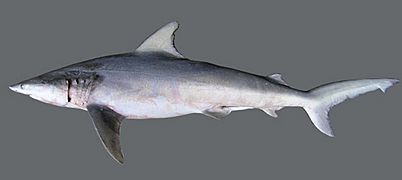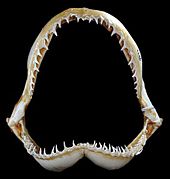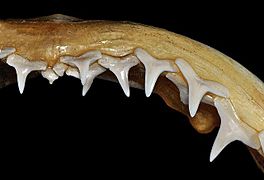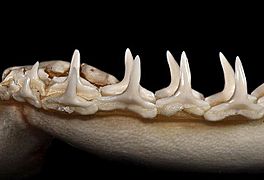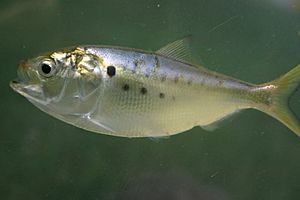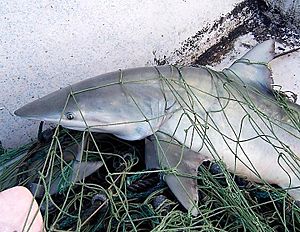Finetooth shark facts for kids
Quick facts for kids Finetooth shark |
|
|---|---|
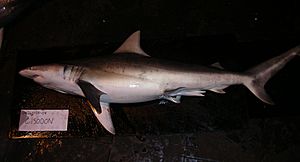 |
|
| Conservation status | |
| Scientific classification | |
| Genus: |
Carcharhinus
|
| Species: |
isodon
|
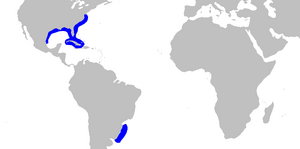 |
|
| Range of the finetooth shark | |
| Synonyms | |
|
Aprionodon punctatus Gill, 1861 |
|
The finetooth shark (Carcharhinus isodon) is a type of requiem shark. It lives in the western Atlantic Ocean, from North Carolina to Brazil. These sharks often swim together in large schools in shallow waters near the coast. They also migrate (move) with the seasons, following warmer water.
This shark is quite small and slender. You can tell it apart by its needle-like teeth and dark blue-gray back. It also has long gill slits. The finetooth shark can grow up to 1.9 meters (6.2 feet) long. It mainly eats small bony fishes, especially menhaden. Like other sharks in its family, the finetooth shark is viviparous. This means the mother gives birth to live pups. Females usually have two to six pups in special nursery areas every two years.
People value the finetooth shark for its meat. It is an important part of the commercial gillnet shark fishery in the southeastern United States. Studies show that this fishing does not currently harm the shark populations in the U.S. Because of this, the International Union for Conservation of Nature (IUCN) lists the finetooth shark as "Least Concern". This means it is not currently in danger. However, there isn't much data for sharks off South America. This shark is not known to be dangerous to humans. But it can snap quickly when caught, so it should be handled carefully.
Contents
About the Finetooth Shark's Name
The finetooth shark was first described in 1839 by a French zoologist named Achille Valenciennes. He called it Carcharias (Aprionodon) isodon. The first shark studied was a young male, about 65 cm (26 inches) long. It was probably caught near New York. Later, this shark was moved into the group (genus) called Carcharhinus.
The name isodon comes from Greek words meaning "equal teeth". This is because the shark has a similar number of teeth in its upper and lower jaws. This shark is sometimes also called the eventooth shark or smoothtooth shark.
How Finetooth Sharks Look
The finetooth shark has a thin, smooth body. Its snout (nose) is long and pointed. It has large, round eyes with special protective eyelids called nictitating membranes. The mouth is wide with grooves at the corners. It has 12 to 15 rows of teeth on each side of its upper jaw and 13 to 14 rows on each side of its lower jaw. Each tooth is small and needle-like.
The shark has five pairs of long gill slits. These are about half the length of its first dorsal fin (the fin on its back). The first dorsal fin is tall and triangular. It starts just in front of the pectoral fins (fins on its sides). The second dorsal fin is fairly large and is located above the anal fin (fin near its tail). There is no ridge between the two dorsal fins. The pectoral fins are small and shaped like sickles.
The shark's skin has tiny, overlapping scales called dermal denticles. Each one has three ridges. Living finetooth sharks are a dark bluish-gray on top and white underneath. They have a faint pale stripe along their sides. Their fins usually don't have any special markings. Some sharks from Florida have green eyes. Male finetooth sharks are about 1.6 meters (5.2 feet) long, and females are about 1.7 meters (5.4 feet). The largest finetooth shark ever recorded was 1.9 meters (6.2 feet) long.
Where Finetooth Sharks Live
In North America, finetooth sharks are common from North Carolina to the northern Gulf of Mexico. They sometimes travel as far north as New York. In Central and South America, they are rare. However, they might live in more places than we currently know. They have been seen near Trinidad, Guyana, and off southern Brazil.
The finetooth sharks in the northwestern Atlantic, Gulf of Mexico, and South America are different groups. They don't mix much. Old reports of this shark in the eastern Atlantic were probably mistakes. Those sharks were likely spinner sharks.
Finetooth sharks often live near beaches, in bays, and in estuaries (where rivers meet the sea). They prefer very shallow waters. In summer, they stay in water no deeper than 10 meters (33 feet). In winter, they go a bit deeper, up to 20 meters (66 feet). Historically, they would swim into rivers in Texas. But now, dams block most paths to these areas.
The finetooth sharks in the northwestern Atlantic move a lot. Young sharks, then adults, arrive off South Carolina from late March to early May. This happens when the water temperature goes above 20°C (68°F). They stay there until September or mid-October. Then, as the water gets colder, they move south to Florida. We don't know much about the movements of other finetooth shark populations.
Finetooth Shark Habits and Diet
Adult and young finetooth sharks swim in large schools. These sharks are energetic and fast-moving predators. They mainly eat small bony fishes. They often go into the surf zone (where waves break) during the day to hunt.
In the northwestern Atlantic, the most important food for this shark is the Atlantic menhaden. Sharks of all ages off northwestern Florida eat almost nothing else. They swallow menhaden whole after removing the head. Other fish they eat include spot croaker, Spanish mackerel, and mullet. They also eat shrimp. In one case, a young Atlantic sharpnose shark was found in a finetooth shark's stomach. This might have been scavenged from fishing waste. Larger sharks may hunt finetooth sharks.
Finetooth Shark Life Cycle and Reproduction
Like other requiem sharks, the finetooth shark is viviparous. This means the mother carries her young inside her body. The developing embryos get food from a yolk for the first 15 weeks. After that, the yolk sac becomes a placenta. This connects the embryo to the mother, providing nutrients.
Female finetooth sharks give birth to two to six pups every two years. In the northwestern Atlantic, mating happens from early May to early June. The young are born around the same time the next year, after a 12-month gestation period. Males bite the female to hold her during mating. Newborn finetooth sharks are about 48 to 64 cm (19 to 25 inches) long. Shallow bays and estuaries, like Bull's Bay in South Carolina, are very important nursery areas for young sharks.
Female finetooth sharks grow slower than males but reach a larger size. Sharks in the northwestern Atlantic are bigger and mature later than those in the Gulf of Mexico. In the northwestern Atlantic, males mature at about 99 cm (39 inches) long, around 5 years old. Females mature at about 102 cm (40 inches) long, around 6 years old. In the Gulf of Mexico, males mature at 94 cm (37 inches) and females at 99 cm (39 inches). This happens at ages 4 and 5 years, respectively. Finetooth sharks can live for at least 9 years for males and 14 years for females.
Finetooth Sharks and People
The finetooth shark has never attacked a human. However, when caught, this shark thrashes around and snaps. People have been bitten when trying to handle them. Finetooth sharks are eaten fresh or dried and salted.
This shark is not very important for fishing outside the southeastern United States. It is small and lives in shallow water, which most fishing boats avoid. It is also too fast for many shrimp trawlers to catch. Some are caught by accident on longlines or with hooks. This species can be easily overfished because it doesn't have many pups. Its coastal habitat also makes it vulnerable to habitat damage.
Many finetooth sharks are caught in large nets called drift gillnets. These are used by the shark fishery off the southeastern United States. The number caught was highest in 1999. Studies in 2007 found that the number of finetooth sharks in U.S. waters was stable. Fishing for this shark in the U.S. is managed by the National Marine Fisheries Service. The IUCN has listed the finetooth shark as "Least Concern" overall. However, there is concern for this species in South America. Here, their numbers seem naturally low, and they might be heavily fished. But the IUCN does not have enough information to fully assess their status there.
See also
 In Spanish: Tiburón dentiliso para niños
In Spanish: Tiburón dentiliso para niños



